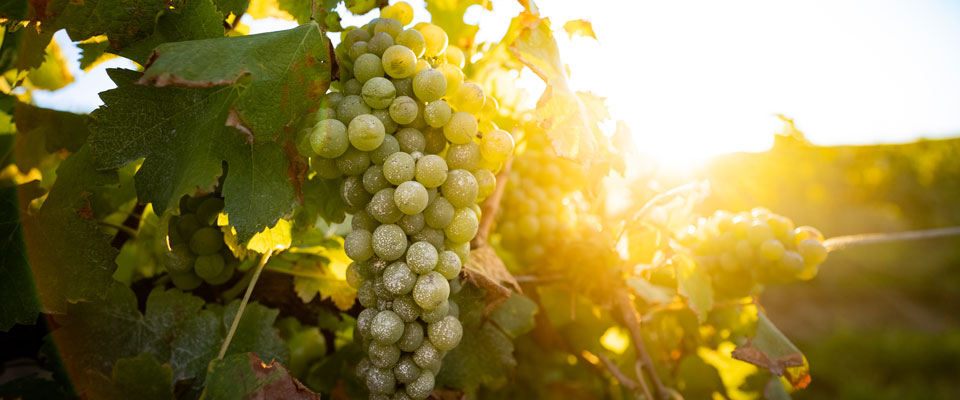Slip Slop Slap: Using Sunscreen on Grapes

Sound absurd that we’d put sunscreen on grapes? Think again – it’s one of the tools in our viticultural toolkit that we use to preserve the quality! We make sure that our family are covered in sunscreen when we are out in the warmer months. So why not take as much care to protect our vines (yes, you could call them our family too) to ensure that the best quality fruit makes it to the winery at vintage time?
As we experience more variable climatic conditions during Spring and Summer, ‘sunscreen’ is a relatively new tool in our viticultural toolbox. Originally developed for the apple industry, it’s a process that Liz Riley has helped pioneer here in Australia for the wine industry, and it’s now widely being adopted across many regions that experience high temperatures prior to harvesting.
Read on to discover just how we use this special tool in the vineyard to preserve the quality of our grapes.
How does sunscreen work to protect the grapes?
In short, sunscreen provides a barrier for the grapes where they are exposed to the sun. The physical product is an inert, organic kaolin clay, which is sprayed on the vines covering the fruit and leaves dusting them with that familiar white coat sunscreen. The product is organic, and is washed away with rain. When driving through the Hunter Valley, you’ll be able to clearly see which vineyards have had their sunscreen applied.
We are selective about where we apply sun protection, depending on the aspect and elevation of the vineyard and even the types of grapes within (some are more susceptible to heat events, kind of like our fair skinned friends who need to be extra diligent in the sun).
The process has been widely tested over the last decade – we’ve found that some of the blocks where sunscreen is used allows the grapes to ripen earlier, with less sunburn and this results in cleaner and brighter wines in the winery.
Plus, there are even more functions to this technology to allow us to beat the heat.
What other benefits does grape sunscreen offer?
Aside from providing that physical barrier, sunscreen also helps to reflect heat leading to cooler canopy temperatures and sustaining canopy function when the vines would otherwise shut down prematurely.
We actually came across this side benefit accidently, as we were focused on the grapes initially but then started to notice the positive impact on the canopy the spray had inadvertently covered. The sustained canopy helps maintain fruit ripening, when otherwise the vine may slow down due to stress in a heat event (similar to heat exhaustion we might experience). Therefore, as ripening fastens, we can bring the fruit in to the winery a littler early than we otherwise would be able to, avoiding our exposure to more damaging heat or as is the case in the Hunter Valley, dreaded extreme rain events! We also need to use less water in the vineyard.
We have also experienced optimisation in the winery thanks to the impact sunscreen has on the grapes. Preventing the fruit from getting hot is beneficial for our press, as fruit that has suffered from the heat tends to get mushy and blocks up the screen. By avoiding this we can move through pressing at a faster pace, then bring in more grapes earlier rather than push picking back. It’s a more efficient and therefore more sustainable vintage as we save on both power and water.
A Decade of Testing: Now Reaping the Rewards
Our Viticulturist Liz Riley has been one of the key champions of this new method of protecting the grapes prior to harvest, particularly on Semillon. It’s one of the reasons Liz was named 2023 WINE Magazine Viticulturist of the Year. Liz had seen a poster about sunscreen at a technical conference and having seen the impact of heat on the grapes in the Hunter, she was keen to learn more. Yalumba had used the technique on Riesling in their Pewsey Vale Vineyard in the Eden Valley and the results were looking positive. A trial was started in 2013/14 Hunter Valley vintage where the special clay was trialled. The Scarborough vineyards were at the forefront of the trials, along with vineyards by McWilliams (now Mount Pleasant Lovedale) and Bimbadgen. It was a highly visible trial creating much intrigue in the Valley.
Liz explained that “when temperatures are over 35 degrees vine photosynthesis is significantly decreased, which means a substantial reduction in the rate of fruit ripening. That is a long period without a lot of activity. When sunscreen is used, because it is white and reflecting heat, vine temperatures are staying cooler for longer (still reaching 40°C but only at a later point in the day).’
You can read more about Liz’s findings in this Wine Australia Research paper.
Overall, the ability to use the protection of physical sunscreen on our vineyards has been instrumental in ensuring that the fruit flavours of the grape are kept fresh, and the vibrant colours of our soon to be wines are preserved. Something to look out for prior to us harvesting on your next trip to the Hunter Valley.
Want to know more about what we do in the vineyard? Learn all about it here:
